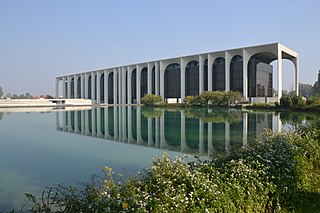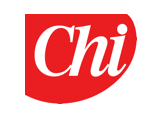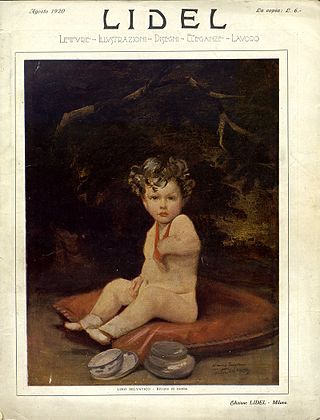
la Repubblica is an Italian daily general-interest newspaper with an average circulation of 151,309 copies in May 2023. It was founded in 1976 in Rome by Gruppo Editoriale L'Espresso and led by Eugenio Scalfari, Carlo Caracciolo, and Arnoldo Mondadori Editore as a leftist newspaper, which proclaimed itself a "newspaper-party". During the early years of la Repubblica, its political views and readership ranged from the reformist left to the extraparliamentary left. Into the 21st century, it is identified with centre-left politics, and was known for its anti-Berlusconism, and Silvio Berlusconi's personal scorn for the paper.
il Giornale, known from its founding in 1974 until 1983 as il Giornale nuovo, is an Italian-language daily newspaper published in Milan with an average circulation of 28,933 copies in May 2023. In 2006, it was considered one of Italy's main national newspapers.

Grazia is a weekly women's magazine that originated in Italy with international editions printed in Albania, Argentina, Australia, Bahrain, Bulgaria, China, Croatia, Colombia, France, Germany. Greece, Indonesia, India, Jordan, Macedonia, Mexico, the Netherlands, Poland, Portugal, Pakistan, Qatar, Serbia, Slovenia, South Korea, Spain, Thailand, and the United Kingdom.

Arnoldo Mondadori Editore is the biggest publishing company in Italy.

Bruno Munari was "one of the greatest actors of 20th-century art, design and graphics". He was an Italian artist, designer, and inventor who contributed fundamentals to many fields of visual arts in modernism, futurism, and concrete art, and in non-visual arts with his research on games, didactic method, movement, tactile learning, kinesthetic learning, and creativity. On the utility of art, Munari once said, "Art shall not be separated from life: things that are good to look at, and bad to be used, should not exist".

L'Espresso is an Italian progressive weekly news magazine. It is one of the two most prominent Italian weeklies; the other is the conservative magazine Panorama. Since 2022, it has been published by BFC Media. From 7 August 2016 to 10 September 2023, it was published on Sundays in mandatory combination with the newspaper la Repubblica.

Chi is an Italian weekly gossip magazine geared towards a female viewership published in Milan, Italy.

Maria Elvira "Marina" Berlusconi is an Italian businesswoman. She is the chairwoman of the holding company Fininvest and the publishing company Arnoldo Mondadori Editore, the latter being the biggest publishing company in Italy. She is the oldest daughter of businessman and former Italian prime minister Silvio Berlusconi.
Gente is a popular and long-running Italian weekly current affairs and celebrity gossip magazine.

Oggi is an Italian weekly news magazine published in Milan, Italy. Founded in 1939 it is one of the oldest magazines in the country.

Epoca was an illustrated weekly current events magazine published between 1950 and 1997 in Milan, Italy. It was one of the leading magazines during its run.
Novella 2000 is a weekly celebrity and women's magazine published in Milan, Italy. Founded in 1919, it is one of the oldest publications in the country. It is also one of the most read and well-known Italian gossip magazines.
Candido was a satirical magazine published in Milan, Italy, between 1945 and 1961. It was cofounded and edited by Giovannino Guareschi.
Noi donne is a monthly feminist magazine published in Rome, Italy. It is one of the most significant feminist publications in the country.

Vie Nuove was a weekly popular magazine published in Rome, Italy, between 1946 and 1978. The magazine was one of the post-war publications of the Italian Communist Party which used it to attract larger sections of the population.
Omnibus was a weekly illustrated general cultural magazine published in Milan, Italy, between 1937 and 1939. Its subtitle was settimanale di attualità politica e letteraria. It is described as the "father of Italian magazines", especially in regard to the use of photographs and images. The magazine was closed by the fascist authorities.

Lidel was a nationalist women's fashion magazine which was in circulation Milan, Italy, in the period 1919–1935. The title was a reference to its founder's name, Lydia Dosio De Liguoro, as well as to the words Letture, illustrazioni, disegni, eleganze, lavori. The magazine played a significant role in the birth of Italian fashion, but at the same time became one of the most militant publications of Fascist Italy.
Asso di bastoni was a weekly satirical and political magazine which was headquartered in Rome, Italy. It was in circulation between 1948 and 1957. The magazine was the organ of the Repubblica Sociale Italiana which was established by the members of the Italian Social Movement, a neo-fascist political party.
Eva was a weekly women's magazine which was published between 1933 and 1968 in Milan, Italy, with a two-year interruption. Its subtitle was settimanale per la donna italiana. Eva was one of the leading illustrated magazines of the period.












